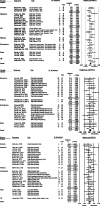Efficacy of non-invasive brain stimulation on cognitive functioning in brain disorders: a meta-analysis
- PMID: 33070785
- PMCID: PMC7737055
- DOI: 10.1017/S0033291720003670
Efficacy of non-invasive brain stimulation on cognitive functioning in brain disorders: a meta-analysis
Abstract
Background: Cognition is commonly affected in brain disorders. Non-invasive brain stimulation (NIBS) may have procognitive effects, with high tolerability. This meta-analysis evaluates the efficacy of transcranial magnetic stimulation (TMS) and transcranial Direct Current Stimulation (tDCS) in improving cognition, in schizophrenia, depression, dementia, Parkinson's disease, stroke, traumatic brain injury, and multiple sclerosis.
Methods: A PRISMA systematic search was conducted for randomized controlled trials. Hedges' g was used to quantify effect sizes (ES) for changes in cognition after TMS/tDCS v. sham. As different cognitive functions may have unequal susceptibility to TMS/tDCS, we separately evaluated the effects on: attention/vigilance, working memory, executive functioning, processing speed, verbal fluency, verbal learning, and social cognition.
Results: We included 82 studies (n = 2784). For working memory, both TMS (ES = 0.17, p = 0.015) and tDCS (ES = 0.17, p = 0.021) showed small but significant effects. Age positively moderated the effect of TMS. TDCS was superior to sham for attention/vigilance (ES = 0.20, p = 0.020). These significant effects did not differ across the type of brain disorder. Results were not significant for the other five cognitive domains.
Conclusions: Our results revealed that both TMS and tDCS elicit a small trans-diagnostic effect on working memory, tDCS also improved attention/vigilance across diagnoses. Effects on the other domains were not significant. Observed ES were small, yet even slight cognitive improvements may facilitate daily functioning. While NIBS can be a well-tolerated treatment, its effects appear domain specific and should be applied only for realistic indications (i.e. to induce a small improvement in working memory or attention).
Keywords: Brain disorder; cognitive dysfunction; non-invasive brain stimulation; prefrontal cortex; repetitive transcranial magnetic stimulation; transcranial direct current stimulation.
Conflict of interest statement
The authors report no potential conflicts of interest.
Figures



References
-
- Aleman, A., Enriquez-Geppert, S., Knegtering, H., & Dlabac-de Lange, J. J. (2018). Moderate effects of noninvasive brain stimulation of the frontal cortex for improving negative symptoms in schizophrenia: Meta-analysis of controlled trials. Neuroscience and Biobehavioral Reviews, 89, 111–118. 10.1016/j.neubiorev.2018.02.009. - DOI - PubMed
-
- André, S., Heinrich, S., Kayser, F., Menzler, K., Kesselring, J., Khader, P. H., … Mylius, V. (2016). At-home tDCS of the left dorsolateral prefrontal cortex improves visual short-term memory in mild vascular dementia. Journal of the Neurological Sciences, 369, 185–190. 10.1016/j.jns.2016.07.065. - DOI - PubMed
Publication types
MeSH terms
LinkOut - more resources
Full Text Sources
Medical
Research Materials

